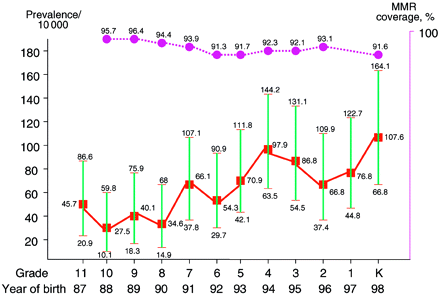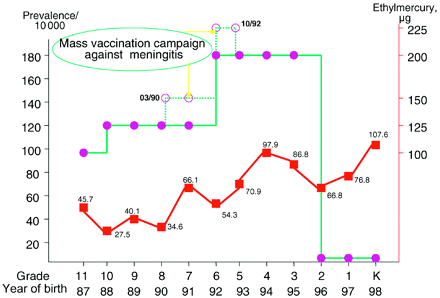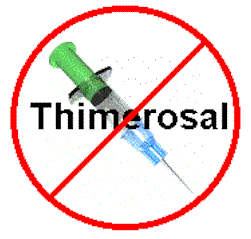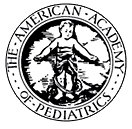

| Home |
| History Lesson |
| What is Autism? |
| What is the MMR Vaccine? |
| Is There a Link? |
| Just the Facts |
| What Parents Need to Know |
| Conclusion |
| References |
What evidence supports there being no relationship between the MMR vaccine and autism? |
|
Thimerosal
One of the most heard words in the majority of arguments against vaccines and the link between them and autism is Thimerosal. Thimerosal is an additive to vaccines used to prevent contamination by bacteria or fungi. Thimerosal contains 46.9% ethyl mercury. Mercury is the second most harmful natural substance to humans, next to uranium. Mercury has been proven to cause neurological damage, among other ailments, and pregnant women are warned against the ingestion of mercury, even warning expectant mothers of eating fish. Autism and autistic spectrum disorders are neurological disorders. Although the Center for Disease Control (CDC) claims that vaccinations no longer contain thimerosal, it must be noted that pharmaceutical companies were not prohibited from using this preservative, but strongly encouraged to or reduce the amount found in certain vaccinations. Seventeen vaccinations contain thimerosal, including the flu shot. Although new vaccinations are being created without thimerosal, vaccinations containing the preservative are still being administered throughout the country (Vaccinations and autism, 2005). Despite this studied connection with thimersol and autism, most people do not understand that not all childhood vaccines contain thimerosal. In fact, according to Margaret C. Fisher, MD of the American Academy of Pediatrics, the MMR vaccine contains no thimersol and since its introduction, it never has (Fisher, 2006).
Studies Disprove Earlier Controversial Ones
In 2001 and again in 2004, the Institute of Medicine (IOM) Immunization Safety Review Committee, an independent body of experts who have no conflict of interest with pharmaceutical companies or organizations that make vaccine recommendations, studied a possible MMR-autism link and found absolutely no evidence supporting such a connection. The Immunization and Safety Review Committee was a project within the IOM that addressed current and emerging vaccine-safety concerns. The committee met three times a year from 2001-2004 and provided independent, non-biased advice to vaccine policy-makers, as well as practitioners and the public. Officially convened in the fall of 2000, the committee was comprised of 15 members with expertise in pediatrics, neurology, immunology, internal medicine, infectious diseases, genetics, epidemiology, biostatistics, risk perception and communication, decision analysis, public health, nursing and ethics. The first report in their series presented an assessment of the evidence regarding a hypothesized casual association between the MMR vaccine and autism, an assessment of the broader significance for society of the issues surrounding the MMR-autism hypothesis, and the committee’s conclusions and recommendations based on those assessments. The 2001 study concluded that the evidence favored rejection of a casual relationship at the population level between the MMR vaccine and autism. The committee’s conclusion was based on 4 important scientific findings: A consistent body of epidemiological evidence shows no association at a population level between MMR vaccine and autism spectrum disorder (ASD, the original case series of children with ASD and bowel symptoms and other available case reports are uninformative with respect to causality, biological models linking MMR vaccine and ASD are fragmentary and no relevant animal model linking MMR vaccine and ASD (Immunization safety review, 2001). The 2004 report by the Immunization Safety Review Committee there was focus on thimerosal-containing vaccines in addition to the MMR vaccines, but the conclusions were still the same: the committee believed evidence favored rejection of a casual relationship between both thimerosal-containing vaccines and the MMR vaccine and autism (Immunization safety review, 2004).
Additional Studies Side with Vaccines
A panel of experts brought together by the American Academy of Pediatrics (AAP) conducted a study which brought about conclusion similar to the Immunization Safety Review Committee’s. In 2008, scientists with the AAP found no link between the MMR vaccine and autism. In response to the study, Renee R. Jenkins, MD, FAAP, president of the AAP released the following statement: “This study adds a critical piece to the mountain of evidence that MMR vaccine does not cause autism. We are hopeful these results will put this theory to rest. Parents should feel confident this life-saving vaccine has been thoroughly researched and found to be safe” (Study shows measles vaccine does not cause autism, 2008). In 2006, a study in the defense of the MMR vaccine specifically was done in Montreal, Quebec, Canada and published in a 2006 issue of the Journal of the American Academy of Pediatrics. The study was more specifically focused on examining an increase in Pervasive Developmental Disorders (PDD), which includes autism. The conductors of this study sought to find if the MMR vaccine was a valid culprit. To support their findings, the Canadian research group surveyed 27749 children born from 1987 to 1998 attending 55 schools. Calculated was MMR vaccine coverage for each birth cohort in the study through surveys of vaccination rates. The study concluded that factors accounting for the increase in PDD included better diagnostic concepts and criteria, increased awareness, and overall better identification of children with PDD. The findings most importantly ruled out any association between PDD, including diagnoses such as autism, and high levels of ethylmercury exposure comparable with those experienced in MMR vaccinations. Below is a chart that illustrates MMR vaccine coverage and PDD rates over time.
As the data suggests, there is an increase in PDD diagnosis even after a decrease in MMR coverage. Another data chart compiled by this study visibly shows that PDD rates started to increase before the change from medium (1987–1991) to high (1992–1995) exposure levels. The highest prevalence rate was found in the 1998 thimerosal-free birth cohort. To note, the dotted lines in the chart takes into account the additional ethylmercury exposure because of a mass vaccination campaign against meningitis during those time periods (Fombonne, 2006).
|
||



